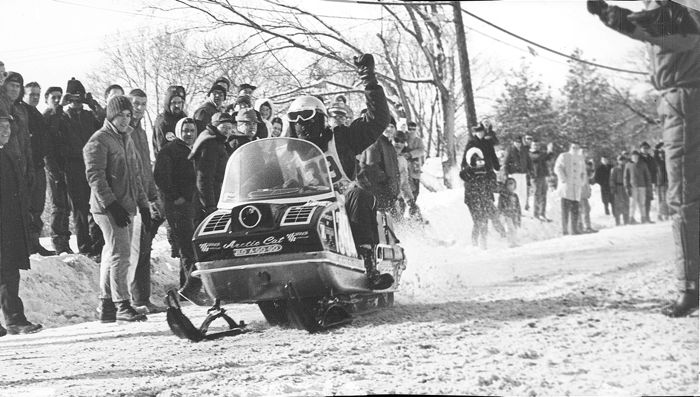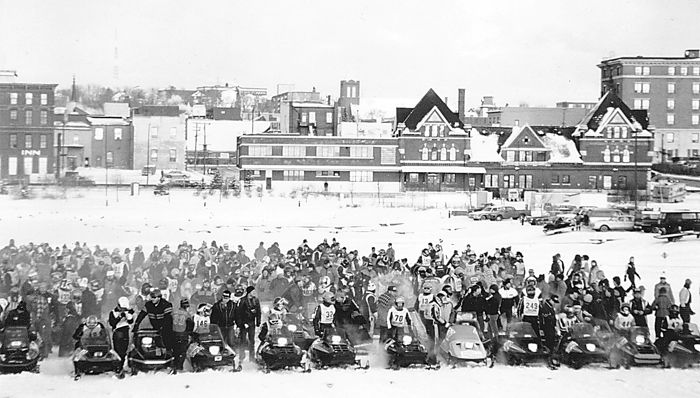
In its nearly 50-year history, cross-country snowmobile racing has experienced several up and down cycles ranging from great health and popularity, to struggling with survival. The first boom in popularity occurred in the 1970s, peaking between 1976-78.
While there were many important one-day events in the sports first 15 years, it was the Winnipeg-to-St. Paul I-500 that served as the sport’s foundation. The prospect of competing in the I-500 attracted the usual pack of professional racers who got paid to compete.
Names often celebrated and revered from this period include Cormican, Janssen, Nelson, Simonson, Karpik and Hayes.
But more important than the big bucks and factory riders, the magnificent race captured the imaginations of everyday riders who dreamed of reaching the finish line of a four-day, 500-mile adventure. These riders were the foundation of the race and the sport of cross-country.
The first precipitous drop in XC participation began in 1980-81, which, not coincidentally, was the first year that the Winnipeg to St. Paul I-500 ceased operation since the inaugural event in 1966.
Cross-country racing wasn’t completely out of gas for most of the 1980s, but it was running on fumes.
In 1987 a consortium snowmobile industry people and XC race organizers resurrected the point-to-point I-500 in the form of the Jeep 500, which ran from Thunder Bay to the Twin Cities and attracted 143 racers in its first run.
Almost instantly, this form of competition grew in participation and prestige. Within four years there would be snowmobiles built specifically for this event (1990 Arctic Cat EXT Special, 1990 Ski-Doo Formula Plus 500 and 1991 Polaris XC 400 among them) and nearly 270 racers throwing in their chip and hoping for a finish.
In the summer of 1992 a former XC racer who’d enjoyed success in the 1970s spearheaded an effort that would launch XC to even greater heights. John Daniels had returned to the sport he loved armed with money he’d made from his trucking business and aiming to make XC profitable for professional racers. He launched the International Series of Champions (ISOC), an umbrella circuit that affiliated with individual races throughout the northern half of Minnesota.
Within two years, XC racing enjoyed immense participation and paydays equal to (or even greater) than its first heyday in the mid-‘70s. New races became instant classics, such as the TRF Ironman 250 and the Albertville 100. And a new generation of racers became heroes, with names like Hibbert, Struthers, Wolff and Pake.
Yet the sport’s real strength was the legion of racers who comprised the bulk of participation, yet whose names seldom appeared in the headlines.
For reasons too numerous to detail here, XC suffered a slow demise beginning in the late 1990s and early 2000s. By 2002 it was once again sputtering on fumes, without the premier I-500 event to serve as its foundation.
In 2003, a former racer took it upon himself to reprise cross-country and the 500-mile event. His name was Pat Mach. His circuit was USCC.
Over the next handful of years, USCC grew Midwestern cross-country participation to a respectable level, with events throughout northwestern Minnesota and eastern North Dakota, including a three-day I-500 based in Thief River Falls. Not the same massive numbers seen in the mid-1970s and mid-1990s, but definitely respectable.
Pat Mach had the goal of resurrecting the Winnipeg-to-St. Paul I-500 for the 2012 season. His belief (which I agreed with) was that a point-to-point event crossing the Canadian/U.S. border would attract more racers due to the challenge, history and drama inherent in such an endeavor.
Unfortunately, Mach was never able to put his dream into action. He died in a snowmobile accident in February 2011.
Together with cadre of former USCC personnel, former two-time I-500 winner Brian Nelson launched USXC beginning with the 2013 race season. The circuit built upon the foundation created by USCC, utilizing many of the same venues and catering to the same core of competitors. While race entries have crept upward these past two years, the sport of XC has seemed to simmer, rather than boil.
When I look back on the history of XC, one fact jumps out at me: Midwestern cross-country racing has been healthiest only when there was a premier 500-mile, point-to-point event.
Chicken or the egg? Both.
The time has come once again for such an event. For the coming 2015 race season, Brian Nelson and the USXC crew are bringing back the Winnipeg point-to-point cross-country race Feb. 11-14. And from the sounds of it, the race will reprise all (and perhaps more) of its former glory.
The event is dubbed Winnipeg-to-Willmar, a four-day, 600-mile event starting in Winnipeg, with overnight stops in Thief River Falls, Bemidji and Alexandria before finishing in Willmar. The course will comprise ditch, river and upwards of 100 miles of trail.
When talking with Nelson over the past month or so, a few facts are very clear:
People have come out of the woodwork to help make this event a reality. From Canadian officials to U.S. Customs representatives to snowmobile clubs to town mayors… a powerful thread of history connects people with this race and inspires them to help bring it back.
The snowmobile racing industry is supporting it, via new rules for XC racing that will result in stock snowmobiles (available from dealerships) rather than purpose-built race sleds. In the various Pro, Semi Pro and Sport 600 classes at all events including the Winnipeg, racers will compete on an Arctic Cat ZR6000RR, Arctic Cat ZR7000 RR, Polaris AXYS Pro-S, Ski-Doo MXZ X 600RS or Yamaha SR Viper R-TX.
These machines run on pump gas (with oil injection standard on the 2-stroke models), are great trail sleds and offer strong resale value. In other words, they’re perfect for the casual or part-time competitor who wants to race one weekend and trail ride the next.
Most importantly, however, the Winnipeg-to-Willmar event has once again captured the imaginations of would-be racers from all over North America. Nelson tells me that he’s receiving dozens of phone calls each week from people who have never raced, or who haven’t raced since the mid-1990s. Hotels are already starting to fill up. The Snowmobile Hall of Fame is planning an I-500 reunion event in Alexandria in conjunction with the race layover before the final leg into Willmar.
There’s a word that describes what is happening with cross-country at this very moment: momentum. If XC has indeed been simmering for the past handful of years, then the Winnipeg event might be heat that brings it to a boil.
Like Brian Nelson… like Pat Mach… and like dozens of other people who have seen the ebbs and flows of cross-country over the years, I believe the grandeur of a point-to-point event like the Winnipeg will grow the sport of cross-country. It will complement events like the Alaskan Iron Dog. It will accelerate the technology incorporated into stock snowmobiles.
And it will provide untold thrills, satisfaction and stories for those who challenge themselves against the fast and rugged terrain that defines this region.
There’s more to come on this race and sport of cross-country.
Thanks for reading.
